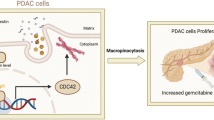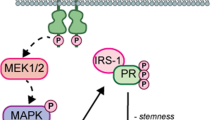Abstract
Both progesterone and the insulin-like growth factors (IGFs) are critically involved in mammary gland development and also in breast cancer progression. However, how the progesterone and IGF signaling pathways interact with each other to regulate breast cancer cell growth remains unresolved. In this study, we investigated progesterone regulation of IGF signaling components in breast cancer cells. We found that insulin receptor substrate-2 (IRS-2) levels were markedly induced by progesterone and the synthetic progestin R5020 in MCF-7 and other progesterone receptor (PR) positive breast cancer cell lines, whereas IRS-1 and the IGF-I receptor were not induced. The antiprogestin RU486 blocked the R5020 effect on IRS-2 expression. Ectopic expression of either PR-A or PR-B in C4-12 breast cancer cells (estrogen receptor and PR negative) showed that progestin upregulation of IRS-2 was mediated specifically by PR-B. The IRS-2 induction by R5020 occurred via an increase of IRS-2 mRNA levels. Furthermore, progestin treatment prior to IGF-I stimulation resulted in higher tyrosine-phosphorylated IRS-2 levels, increased binding of IRS-2 to Grb-2 and the PI3K regulatory subunit p85, and correspondingly enhanced ERK and Akt activation, as compared with IGF-I-only conditions. Taken together, our data suggest that IRS-2 may play an important role in crosstalk between progesterone and the IGFs in breast cancer cells.
This is a preview of subscription content, access via your institution
Access options
Subscribe to this journal
Receive 50 print issues and online access
$259.00 per year
only $5.18 per issue
Buy this article
- Purchase on Springer Link
- Instant access to full article PDF
Prices may be subject to local taxes which are calculated during checkout




Similar content being viewed by others

References
Baserga R . (1995). Cancer Res., 55, 249–252.
Bruning JC, Winnay J, Cheatham B and Kahn CR . (1997). Mol. Cell Biol., 17, 1513–1521.
Chang Q, Li Y, White MF, Fletcher JA and Xiao S . (2002). Cancer Res., 62 (21), 6035–6038.
Dupont J and Le Roith D . (2001). Mol. Pathol., 54, 149–154.
Graham JD and Clarke CL . (1997). Endocr. Rev., 18, 502–519.
Groshong SD, Owen GI, Grimison B, Schauer IE, Todd MC, Langan TA, Sclafani RA, Lange CA and Horwitz KB . (1997). Mol. Endocrinol., 11, 1593–1607.
Jackson JG, White MF and Yee D . (1998). J. Biol. Chem., 273, 9994–10003.
Kastner P, Krust A, Turcotte B, Stropp U, Tora L, Gronemeyer H and Chambon P . (1990). EMBO J., 9, 1603–1614.
Lange CA, Richer JK, Shen T and Horwitz KB . (1998). J. Biol. Chem., 273, 31308–31316.
Lapidus RG, Nass SG and Davidson NE . (1998). J. Mamm. Gland Biol. Neoplasia, 3, 85–94.
Lee AV, Jackson JG, Gooch J L, Hilsenbeck SG, Coronado-Heinsohn E, Osborne CK and Yee D . (1999). Mol. Endocrinol., 13, 787–796.
Lee AV and Yee D . (1995). Biomed. Pharmacother., 49, 415–421.
LeRoith D . (1996). Baillieres Clin. Endocrinol. Metab., 10, 49–73.
Lin VC, Ng EH, Aw SE, Tan MG, Chan VS and Ho GH . (1999). Clin. Cancer Res., 5, 395–403.
Musgrove EA, Lee CS and Sutherland RL . (1991). Mol. Cell. Biol., 11, 5032–5043.
Oesterreich S, Zhang P, Guler RL, Sun X, Curran EM, Welshons WV, Osborne CK and Lee AV . (2001). Cancer Res., 61, 5771–5777.
Richer JK, Jacobsen BM, Manning NG, Abel MG, Wolf DM and Horwitz KB . (2002). J. Biol. Chem., 277, 5209–5218.
Rocha RL, Hilsenbeck SG, Jackson JG, VanDenBerg CL, Weng C, Lee AV and Yee D . (1997). Clin. Cancer Res., 3, 103–109.
Ross RK, Paganini-Hill A, Wan PC and Pike MC . (2000). J. Natl. Cancer Inst., 92, 328–332.
Rossouw JE, Anderson GL, Prentice RL, LaCroix AZ, Kooperberg C, Stefanick ML, Jackson RD, Beresford SA, Howard BV, Johnson KC, Kotchen JM and Ockene J . (2002). JAMA, 288, 321–333.
Schairer C, Lubin J, Troisi R, Sturgeon S, Brinton L and Hoover R . (2000). JAMA, 283, 485–491.
Shaw LM . (2001). Mol. Cell. Biol., 21, 5082–5093.
Surmacz E and Burgaud JL . (1995). Clin. Cancer Res., 1, 1429–1436.
Vassen L, Wegrzyn W and Klein-Hitpass L . (1999). Mol. Endocrinol., 13, 485–494.
Vegeto E, Shahbaz MM, Wen DX, Goldman ME, O'Malley BW and McDonnell DP . (1993). Mol. Endocrinol., 7, 1244–1255.
Wen DX, Xu YF, Mais DE, Goldman ME and McDonnell DP . (1994). Mol. Cell. Biol., 14, 8356–8364.
Yenush L and White MF . (1997). BioEssays, 19, 491–500.
Acknowledgements
We thank Dr Gary Chamness and others in the Breast Center at Baylor College of Medicine for their helpful suggestions, technical assistance, and critical reading of the manuscript. We are grateful to Dr Kathryn Horwitz for providing the PR expression vectors. This work was supported by NIH grant CA94118 to A Lee and USAMRC grant DAMD17-01-1-0133 to X Cui.
Author information
Authors and Affiliations
Corresponding author
Rights and permissions
About this article
Cite this article
Cui, X., Lazard, Z., Zhang, P. et al. Progesterone crosstalks with insulin-like growth factor signaling in breast cancer cells via induction of insulin receptor substrate-2. Oncogene 22, 6937–6941 (2003). https://doi.org/10.1038/sj.onc.1206803
Received:
Accepted:
Published:
Issue Date:
DOI: https://doi.org/10.1038/sj.onc.1206803
Keywords
This article is cited by
-
Successful treatment of multiple intracranial meningiomas with the antiprogesterone receptor agent mifepristone (RU486)
Acta Neurochirurgica (2014)
-
Expression and function of the insulin receptor substrate proteins in cancer
Cell Communication and Signaling (2009)
-
Activation of estrogen signaling pathways collaborates with loss of Brca1 to promote development of ERα-negative and ERα-positive mammary preneoplasia and cancer
Oncogene (2008)
-
Insulin Receptor Substrates (IRSs) and Breast Tumorigenesis
Journal of Mammary Gland Biology and Neoplasia (2008)
-
Insulin receptor substrates mediate distinct biological responses to insulin-like growth factor receptor activation in breast cancer cells
British Journal of Cancer (2006)


